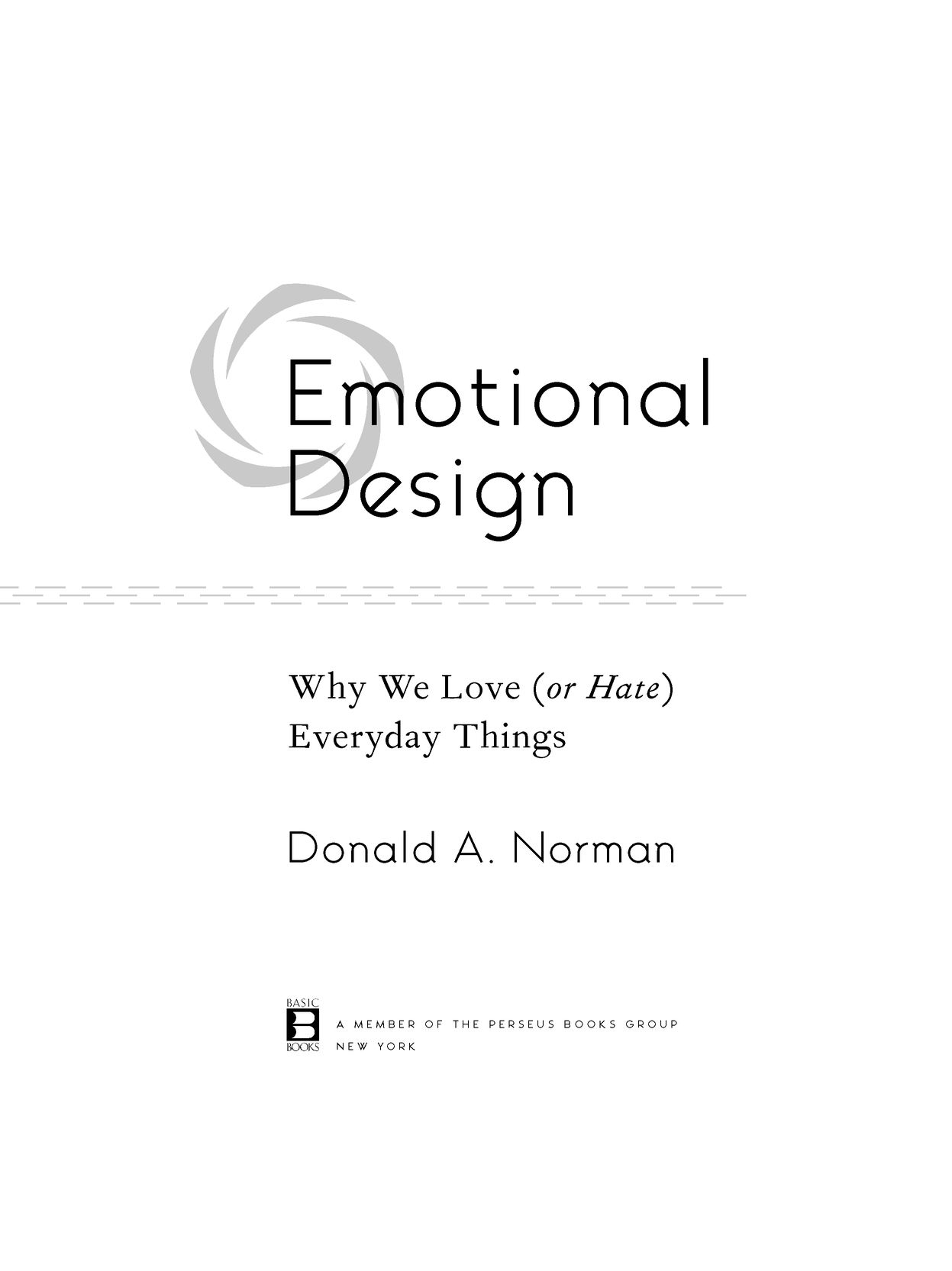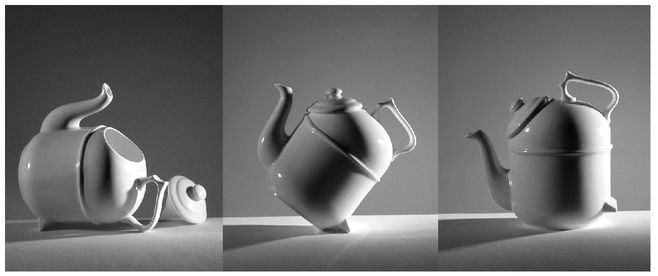Emotional Design
Authors: Donald A. Norman



Table of Contents
Â
Â
Â
Â
PRAISE FOR
EMOTIONAL DESIGN
EMOTIONAL DESIGN
Â
“Norman's analysis of people's emotional reactions to material objects is a delightful process.... His readers will take away insights galore about why shoppers say, âI want that.'”
â
Booklist
Booklist
Â
“Norman's analysis of the design elements in products such as automobiles, watches, and computers will pique the interest of many readers, not just those in the design or technology fields.”
â
Publishers Weekly
Publishers Weekly
Â
“Donald Norman's relentless and exacting exploration of the universe of everyday objects has brought him to the final frontier of design: emotions. His exquisite psychological analysis provides a solid and reliable reference and a most valuable tool.”
âPaola Antonelli, Curator of Architecture and Design, Museum of Modern Art
Â
“Don Norman does it again! He asks the important questions and gives the right answers. I wish this insightful book had been available forty years ago so that I could have done a much better job as a designer.”
âDr. Robert Blaich, former Senior Vice President of Corporate Design, Royal Philips Electronic
Â
“This is a valuable book.... It will help the design world to do great work.”
âPatrick Whitney, Director, Institute of Design, Illinois Institute of Technology
Â
“Amazing . . . Norman does a wonderful job making these ideas come alive.”
âDaniel Bobrow, Research Fellow, Palo Alto Research Center
ALSO BY DONALD A. NORMAN
The Invisible Computer
Â
Things That Make Us Smart
Â
Turn Signals Are the Facial Expressions of Automobiles
Â
The Design of Everyday Things
Â
The Psychology of Everyday Things
Â
User Centered System Design: New Perspectives
on Human-Computer Interaction
(Edited with Stephen Draper)
on Human-Computer Interaction
(Edited with Stephen Draper)
Â
Learning and Memory
Â
Perspectives on Cognitive Science (Editor)
Â
Human Information Processing (With Peter Lindsay)
Â
Explorations in Cognition
(With David E. Rumelhart and the LNR Research Group)
(With David E. Rumelhart and the LNR Research Group)
Â
Models of Human Memory (Editor)
Â
Memory and Attention:
An Introduction to Human Information Processing
An Introduction to Human Information Processing
To Julie

FIGURE 0.1
An impossible teapot.
(Author's collection. Photograph by Ayman Shamma.)
An impossible teapot.
(Author's collection. Photograph by Ayman Shamma.)

FIGURE 0.2
Michael Graves's “Nanna” teapot.
So charming I couldn't resist it.
(Author's collection. Photograph by Ayman Shamma.)
Michael Graves's “Nanna” teapot.
So charming I couldn't resist it.
(Author's collection. Photograph by Ayman Shamma.)

FIGURE 0.3a, b, and c
The Ronnefeldt “tilting” teapot.
Put leaves on the internal shelf (not visible, but just above and parallel to the ridge that can be seen running around the body of the teapot), fill with hot water, and lay the teapot on its back (figure a). As the tea darkens, tilt the pot, as in figure b. Finally, when the tea is done, stand the teapot vertically as in figure c, so the water no longer touches the leaves and the brew does not become bitter.
Put leaves on the internal shelf (not visible, but just above and parallel to the ridge that can be seen running around the body of the teapot), fill with hot water, and lay the teapot on its back (figure a). As the tea darkens, tilt the pot, as in figure b. Finally, when the tea is done, stand the teapot vertically as in figure c, so the water no longer touches the leaves and the brew does not become bitter.
(Author's collection. Photographs by Ayman Shamma.)
PROLOGUE
Three Teapots
If you want a golden rule that will fit everybody, this is it: Have nothing in your houses that you do not know to be useful, or believe to be beautiful.
Â
Â
âWilliam Morris “The Beauty of Life,” 1880Â
Â
I HAVE A COLLECTION OF TEAPOTS. One of them is completely unusableâthe handle is on the same side as the spout. It was invented by the French artist Jacques Carelman, who called it a coffeepot: a “coffeepot for masochists.” Mine is a copy of the original. A picture of it appears on the cover of my book
The Design of Everyday Things.
The Design of Everyday Things.
The second item in my collection is the teapot called Nanna, whose unique squat and chubby nature is surprisingly appealing. The third is a complicated but practical “tilting” pot made by the German firm Ronnefeldt.
The Carelman pot is, by intent, impossible to use. The Nanna teapot, designed by the well-known architect and product designer
Michael Graves, looks clumsy but actually works rather well. The tilting pot, which I discovered while enjoying high tea at the Four Seasons Hotel in Chicago, was designed with the different stages of tea brewing in mind. To use it, I place the tea leaves on a shelf (out of sight in the pot's interior) and lay the pot on its back while the leaves steep. As the brew approaches the desired strength, I prop the pot up at an angle, partially uncovering the tea leaves. When the tea is ready, I set the pot upright, so that the leaves are no longer in contact with the tea.
Michael Graves, looks clumsy but actually works rather well. The tilting pot, which I discovered while enjoying high tea at the Four Seasons Hotel in Chicago, was designed with the different stages of tea brewing in mind. To use it, I place the tea leaves on a shelf (out of sight in the pot's interior) and lay the pot on its back while the leaves steep. As the brew approaches the desired strength, I prop the pot up at an angle, partially uncovering the tea leaves. When the tea is ready, I set the pot upright, so that the leaves are no longer in contact with the tea.
Which one of these teapots do I usually use? None of the above.
I drink tea every morning. At an early hour, efficiency comes first. So, upon awakening, I pad into my kitchen and push the button on a Japanese hot pot to boil water while I spoon cut tea leaves into a little metal brewing ball. I drop the ball into my cup, fill it with boiling water, wait a few minutes for it to steep, and my tea is ready to drink. Fast, efficient, easy to clean.
Why am I so attached to my teapots? Why do I keep them out on display, in the alcove formed by the kitchen window? Even when they are not in use, they are there, visible.
I value my teapots not only for their function for brewing tea, but because they are sculptural artwork. I love standing in front of the window, comparing the contrasting shapes, watching the play of light on the varied surfaces. When I'm entertaining guests or have time to spare, I brew my tea in the Nanna teapot for its charm or in the tilting pot for its cleverness. Design is important to me, but which design I choose depends on the occasion, the context, and above all, my mood. These objects are more than utilitarian. As art, they lighten up my day. Perhaps more important, each conveys a personal meaning: each has its own story. One reflects my past, my crusade against unusable objects. One reflects my future, my campaign for beauty. And the third represents a fascinating mixture of the functional and the charming.
The story of the teapots illustrates several components of product design: usability (or lack thereof), aesthetics, and practicality. In cre-ating
a product, a designer has many factors to consider: the choice of material, the manufacturing method, the way the product is marketed, cost and practicality, and how easy the product is to use, to understand. But what many people don't realize is that there is also a strong emotional component to how products are designed and put to use. In this book, I argue that the emotional side of design may be more critical to a product's success than its practical elements.
a product, a designer has many factors to consider: the choice of material, the manufacturing method, the way the product is marketed, cost and practicality, and how easy the product is to use, to understand. But what many people don't realize is that there is also a strong emotional component to how products are designed and put to use. In this book, I argue that the emotional side of design may be more critical to a product's success than its practical elements.
Other books
The Antiquarian by Julián Sánchez
All the Answers by Kate Messner
Birthday Girl (The Student Union Series Book 1) by Chloe Butler
Suspended In Dusk by Ramsey Campbell, John Everson, Wendy Hammer
Pointe by Brandy Colbert
Confessions of a Hostie by Danielle Hugh
Unknown by Unknown
Edge of Moonlight by Stephanie Julian
While the Women are Sleeping by Javier Marias